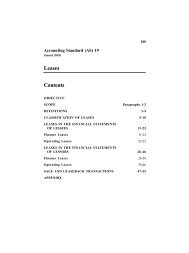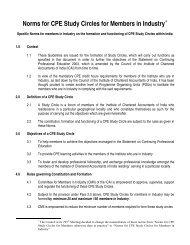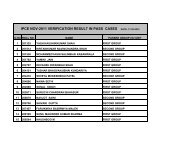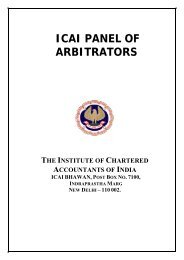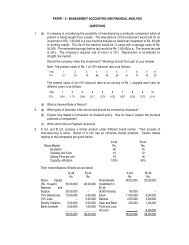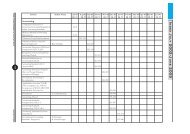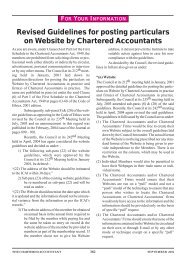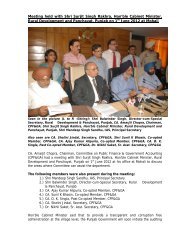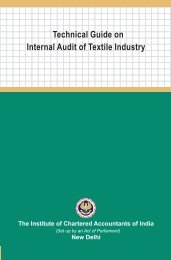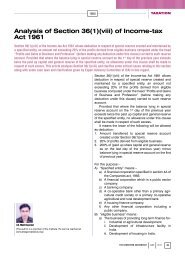The Chartered Accountant
The Chartered Accountant
The Chartered Accountant
You also want an ePaper? Increase the reach of your titles
YUMPU automatically turns print PDFs into web optimized ePapers that Google loves.
and maturity of an enterprise risk<br />
management system and in doing<br />
so, should consider whether the enterprise<br />
has developed a Risk management<br />
policy setting out Roles<br />
and responsibilities and framing a<br />
Risk management activity calendar.<br />
<strong>The</strong> Internal Auditor should review<br />
the maturity of an Enterprise Risk<br />
Management structure by considering<br />
whether the framework so developed,<br />
inter alia:<br />
a) Protects the enterprise against<br />
surprises;<br />
b) Stabilizes overall performance<br />
with less volatile earnings;<br />
c) Operates within established<br />
risk appetite;<br />
d) Protects ability of the enterprise<br />
to attend to its core<br />
business;<br />
e) Creates a system to proactively<br />
manage risks.<br />
10. <strong>The</strong> internal auditor would be responsible<br />
for the following activities:<br />
a) Review of compliance to the<br />
enterprise risk management<br />
b)<br />
process with regard to the existing<br />
internal control systems and<br />
procedures followed.<br />
Defining risk tolerances where<br />
none have been identified, based<br />
on internal auditor’s experience,<br />
judgment, and consultation with<br />
management.<br />
c) Developing a detailed assurance<br />
calendar as a part of their annual<br />
audit plan and submit the review<br />
report to the Committee of the<br />
Board.<br />
d) Reviewing key risk evaluation,<br />
assessment of exposure, recording<br />
and reporting.<br />
e) Expanding assurance activities<br />
to cover overlooked risk areas.<br />
f) Strengthen risk coverage of<br />
technology, fraud and strategic<br />
areas of significant importance<br />
and priority.<br />
g) Coordinate with other risk and<br />
control functions to ensure that<br />
risks are efficiently managed and<br />
controlled.<br />
h) Leveraging and identifying Key<br />
Risk Indicators (KRI) to effec-<br />
EXPOSURE DRAFTS<br />
tively monitor risk conditions.<br />
i) Reviewing whether Enterprise<br />
Risk Management structure is<br />
designed to identify opportunities<br />
to improve performance by<br />
taking maximum advantage of<br />
risk opportunities, focus on risk<br />
control/ risk transfer/ risk finance<br />
and exploit technological<br />
advantages.<br />
j) Providing advice on the design,<br />
implementation and operation<br />
of control systems, identify opportunities<br />
to make control cost<br />
savings.<br />
k) Reviewing and commenting on<br />
the extent of residual risk.<br />
l) Promoting a risk and control<br />
culture within the enterprise.<br />
11. <strong>The</strong> internal auditor should review<br />
whether the enterprise risk<br />
management coordinators in the<br />
entity report on the results of the<br />
assessment of key risks at the appropriate<br />
levels, which are, inter<br />
alia:<br />
l Risk management committee<br />
l Enterprise Business and Unit<br />
heads<br />
l Audit Committee<br />
Internal Audit Plan and Risk<br />
Assessment<br />
12. <strong>The</strong> internal auditor will normally<br />
perform an annual risk assessment of<br />
the enterprise, to develop a plan of<br />
audit engagements for the subsequent<br />
period. This plan will be reviewed at<br />
various frequencies in practice. This<br />
typically involves review of the various<br />
risk assessments performed by the enterprise<br />
(e.g., strategic plans, competitive<br />
benchmarking, etc.), consideration<br />
of prior audits, and interviews with<br />
a variety of senior management. It is<br />
designed for identifying internal audit<br />
key areas, not to identify, prioritize,<br />
and manage risks directly for the enterprise.<br />
<strong>The</strong> internal audit plan, which<br />
should be approved by the audit<br />
committee, should be based on<br />
risk assessment as well as on issues<br />
highlighted by the audit committee<br />
and senior management. <strong>The</strong> risk<br />
assessment process should be of a<br />
continuous nature so as to identify<br />
not only residual or existing risks,<br />
but also emerging risks. <strong>The</strong> risk<br />
assessment should be conducted<br />
formally at least annually, but<br />
more often in complex enterprises.<br />
To serve this objective, the internal<br />
auditor should design the audit<br />
work plan by aligning it with the<br />
objectives and risks of the enterprise<br />
and concentrate on those issues<br />
where assurance is sought by<br />
those charged with governance.<br />
13. <strong>The</strong> risk review and assurance process<br />
to be carried out by the internal<br />
auditor provides the assurance that<br />
there are appropriate controls in place<br />
for the risk management activities and<br />
that the procedures are understood<br />
and followed. Effective enterprise risk<br />
management requires a monitoring<br />
structure to ensure that the risks are<br />
effectively identified and assessed and<br />
that the appropriate mitigation plans<br />
are in place.<br />
14. <strong>The</strong> review and assurance process<br />
conducted by internal auditors will<br />
help to determine, inter alia<br />
a) <strong>The</strong> adopted measures results<br />
in what was intended;<br />
b) <strong>The</strong> procedures adopted and<br />
information gathered for undertaking<br />
the assessment were<br />
appropriate;<br />
c) Improved knowledge would<br />
help in reaching better decisions<br />
and identify what lessons<br />
should be learnt to improve<br />
future assessment and management<br />
of risks.<br />
15. <strong>The</strong> internal auditor should<br />
submit his report to the Committee<br />
of the Board delineating the<br />
following information:<br />
- Assurance rating;<br />
- Test conducted;<br />
- Sample covered; and<br />
- Detailed assurance comments.<br />
Effective Date<br />
16. This Standard on Internal Audit<br />
is applicable to all internal audits<br />
commencing on or after ______.<br />
Earlier application of the SIA is<br />
encouraged.q<br />
THE CHARTERED ACCOUNTANT 1111 DECEMBER 2008



